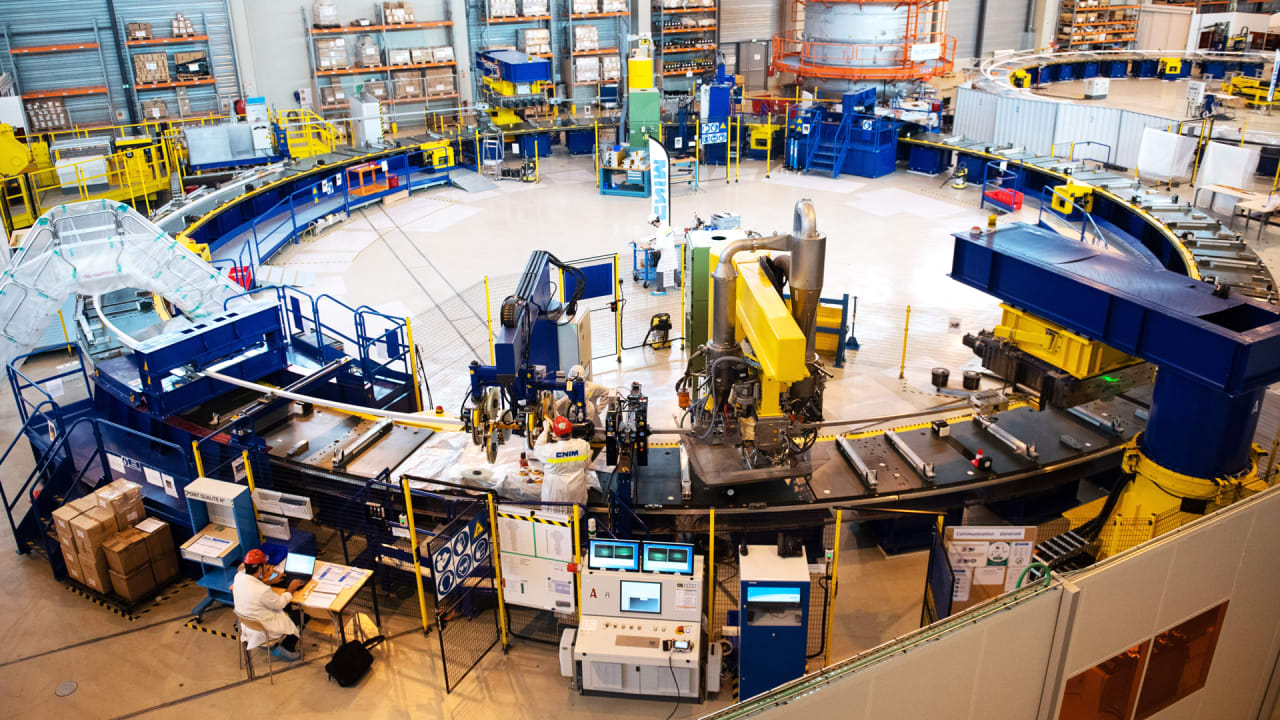
One morning last December, the company fired up its newest supermagnet—a 10-ton, 8-foot-tall device made of hundreds of tightly-twisted coils—and quietly pushed its magnetic field beyond a whopping 20 tesla, a record for a magnet of its size. (Most MRIs operate at a strength of about 1 tesla.) Eventually, 18 of these magnets will surround the SPARC’s tokamak, which CFS says could produce as much as 11 times more energy than it consumes, and at prices cheaper than fossil fuels. Mumgaard estimates the world will need something to replace the world’s 60,000 carbon-emitting power stations, which account for about half of global energy use. Ten thousand fusion plants would do it.
“The exciting part about this technology is that by shrinking the scale and keeping the power the same, we make more ‘power per stuff,’ which makes it much more likely to be economically competitive,” Mumgaard told Fast Company in 2018. “The types of materials that are in this are materials that are commodities, and if you add up those materials you get a cost of electricity that undercuts existing energy prices.”
TAE Technologies
Southern California-based TAE Technologies has raised a whopping $1.2 billion since it was founded in 1998, and $250 million in its latest round. The round, announced in July, was led by Chevron’s venture arm, Google, and Sumitomo, a Tokyo-based holding company that aims to deploy fusion power in the Asia-Pacific market. TAE’s approach, which involves creating a fusion reaction at incredibly high heat, has a key advantage. Whereas ITER uses the hydrogen isotopes deuterium and tritium, an extremely rare element that must be specially created from lithium—and that produces as a byproduct radioactive-free neutrons—TAE’s linear reactor is completely non-radioactive, because it relies on hydrogen and boron, two abundant, naturally-occurring elements that react to produce only helium.
The problem is, this requires temperatures on the order of one billion degrees Celsius. (By comparison, ITER requires only a temperature of 150 million degrees Celsius. The sun’s core, its hottest part, can be as hot as 15 million degrees Celsius.) TAE says that its current test reactor has managed to keep plasma stable at 75 million degrees Celsius, or 167 million Fahrenheit—more than twice its initial target. With its double-decker-bus-sized machine, which it says currently costs over $250 million to construct, the company is aiming to build an even larger machine, Copernicus, to do the test at double the heat. It says it plans to start delivering power to grids by 2030, followed by “broader commercialization” during the next decade.
Milestone achieved—and surpassed! ✅
TAE Technologies’ state-of-the-art fusion research reactor Norman has achieved temperatures greater than 75 million° C while demonstrating unmatched real-time control of plasma. (1/6) pic.twitter.com/VEw7RMhWYd
— TAE Technologies (@TAE) July 19, 2022
General Atomics
General Atomics, of San Diego, California, has the largest tokamak in the U.S. Its powerful magnetic chamber, called the DIII-D National Fusion Facility, or just “D-three-D,” now features a Toroidal Field Reversing Switch, which allows for the redirection of 120,000 amps of the current that power the primary magnetic field. It’s the only tokamak in the world that allows researchers to switch directions of the magnetic fields in minutes rather than hours. Another new upgrade, a traveling-wave antenna, allows physicists to inject high-powered “helicon” radio waves into DIII-D plasmas so fusion reactions occur much more powerfully and efficiently.
“We’ve got new tools for flexibility and new tools to help us figure out how to make that fusion plasma just keep going,” Richard Buttery, director of the project, told the San Diego Union-Tribune in January. The company is also behind eight of the magnet modules at the heart of the ITER facility, including its wild Central Solenoid — the world’s most powerful magnet — in a kind of scaled up version of the California machine.
But like an awful lot in fusion, ITER has been hampered by cost overruns and delays, with “first plasma” not expected to occur in 2025 as previously expected due to global pandemic-related disruptions. Some have complained that the money going to ITER has distracted from other more practical energy projects—the latest price tag is $22 billion—and others doubt if the project can ever produce net energy gain.
When completed, the plasma circulating in the fusion reactor ITER's core will be 270 million °C, 10 times hotter than the Sun. The magnets surrounding the core will be cooled to -268°C, as cold as the depths of space. ITER is now halfway to 'first plasma' https://t.co/46EjFRLT0C pic.twitter.com/GyMCJFDYLe
— Massimo (@Rainmaker1973) February 10, 2020
General Fusion
Based in Canada, General Fusion is backed by Jeff Bezos and building on technology originally developed by the U.S. Navy and explored by Russian scientists for potential use in weapons. Inside the machine, molten metal is spun to create a cavity, and pumped with pistons that push the metal inward to form a sphere. Hydrogen, heated to super-hot temperatures and held in place by a magnetic field, fills the sphere to create the reaction. Heat transferred to the metal can be turned into steam to drive a turbine and generate electricity. As former CEO Christofer Mowry told Fast Company last year, “to re-create a piece of the sun on Earth, as you can imagine, is very, very challenging.” Like many fusion companies, GF depends on modern supercomputers and advanced modeling and computational techniques to understand the science of plasma physics, as well as modern manufacturing technologies and materials.
“That’s really opened the door not just to being able to make fusion work but to make it work in a practical way,” Mowry said. This has been difficult to make work, but with a demonstration center it announced last year in Culham, England, GF isn’t aiming to generate electricity but to gather the data needed to later build a commercial pilot plant that could—and to generate more interest in fusion.
“Part of what we want to do with this demonstration plant is make the promise of fusion something that is more in the public’s consciousness, and in the policymakers’ consciousness, so as they plot what the future energy systems look like, they consider how to incorporate fusion in that,” Mowry said. “Because it will be coming here faster than people realize.”
MIFTI
Magneto-Intertial Fusion Technologies, or MIFTI, of Tustin, Calif., founded by researchers from the University of California, Irvine, is developing a reactor that uses what’s known as a Staged Z-Pinch approach. A Z-Pinch design heats, confines, and compresses plasma using an intense, pulsed electrical current to generate a magnetic field that could reduce instabilities in the plasma, allowing fusion to persist for longer periods of time. But only recently have MIFTI’s scientists been able to overcome the instability problems, the company says, thanks to software made available to them at UC-Irvine by the U.S. Air Force. MIFTI is predicting an energy gain from ten to fifty times the energy used to create it. Since its launch in 2008, the company has raised $1.6 million in venture capital and received a $4.5 million award from the Dept. of Energy’s ARPA-E program. Separate research on Z-pinch chambers at Lawrence Livermore National Laboratory spun off another fusion startup, Seattle-based Zap Energy, which announced a $160 million Series C round in July.
Princeton Fusion Systems
Princeton Fusion Systems of Plainsboro, New Jersey, is a small business focused on developing small, clean fusion reactors for both terrestrial and space applications. A spinoff of Princeton Satellite Systems, which specializes in spacecraft control, the company’s Princeton FRC reactor is built upon 15 years of research at the Princeton Plasma Physics Laboratory, funded primarily by the U.S. DOE and NASA, and is designed to eventually provide between 1 and 10 megawatts of power in off-grid locations and in modular power plants, “from remote industrial applications to emergency power after natural disasters to off-world bases on the moon or Mars.” The concept uses radio-frequency electromagnetic fields to generates and sustain a plasma formation called a Field-Reversed Configuration (FRC) inside a strong magnetic bottle. The experiment at Princeton holds the record for the longest time that such a reaction has been stably held—at 300 ms. Princeton has attracted over $2.5 million in grants from the Dept. of Energy’s ARPA-E advanced technology program.
Tokamak Energy
Tokamak Energy, a U.K.-based company named after the popular fusion device, announced in July that its ST-40 tokamak reactor had reached the 100 million Celsius threshold for commercially viable nuclear fusion. The achievement was made possible by a proprietary design built on a spherical, rather than donut, shape. This means that the magnets are closer to the plasma stream, allowing for smaller and cheaper magnets to create even stronger magnetic fields. The Princeton Large Torus tokamak first reached this temperature threshold in 1978, but Tokamak’s is the first to do so with a spherical, privately-funded device. The company has raised nearly $100 million from investors including Legal & General, in addition to grants from the Dept. of Energy.
Helicity Space
Based in Pasadena, California, Helicity Space is developing a propulsion and power technology based on a specialized magneto inertial fusion concept. The system, a spin on what fellow fusion engineer, Seattle-based Helion is doing, appears to use twisted compression coils, like a braided rope, to achieve a known phenomenon called the Magnetic Helicity. (See a description in this presentation.) According to ZoomInfo and Linkedin, Helicity has over $4 million in funding and up to 10 employees, all aimed, the company says, at “enabling humanity’s access to the solar system, with a Helicity Drive-powered flight to Mars expected to take two months, without planetary alignment.”





